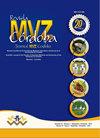哥伦比亚克里奥尔羊的遗传多样性
IF 0.3
4区 农林科学
Q4 AGRICULTURE, DAIRY & ANIMAL SCIENCE
引用次数: 11
摘要
Ojective。哥伦比亚克里奥尔羊的遗传特征及其与欧洲起源品种的关系。材料和方法。在8个省(科尔多瓦、马格达莱纳、塞萨尔、Atlantico、cauka山谷、Narino、Boyaca、Tolima)的40个农场采集了以下种群261只羊的血样:Criollos de Lana (CL)、Mora Colombiana (MC)、Criollo de Pelo (CP)、Criollos mestizos (Mes)、Hampshire (Hamp)、Corriedale (Corr)、Katahdin (Kath)、Pelibuey (Pel),以及30只西班牙美利奴、美利奴Precoz (MP)、Merinofleischschaf (MF)、Segureno (Seg)和Uda (UD) de Nigeria。本研究共纳入15个微卫星标记。结果。克里奥尔羊平均等位基因数分别为6.20±1.48 (CL)、7.27±1.39 (CP)和3.60±1.55 (MC);遗传多样性高(杂合度高75%),FIS值为负值表明遗传渗入程度高;此外,FST还揭示了克里奥尔羊(FST=0.02**)和科(FST=0.039**)的遗传结构。根据遗传距离,克里奥尔哥伦比亚羊与外来羊不同。结论。研究结果建议保护克里奥尔羊的生产,因为它一直受到与外国品种杂交的威胁,这将导致克里奥尔羊自身遗传特性和适应性特征的丧失。本文章由计算机程序翻译,如有差异,请以英文原文为准。
Diversidad genética de ovinos criollos colombianos
Ojective. genetical characterization the creole Colombian sheep and their relationships with breeds of European origins. Materials and methods. Blood samples of 261 sheeps from the following populations were collected: Criollos de Lana (CL), Mora Colombiana (MC), Criollo de Pelo (CP), criollos mestizos (Mes), Hampshire (Hamp), Corriedale (Corr), Katahdin (Kath), Pelibuey (Pel), in 40 farms of 8 departments (Cordoba, Magdalena, Cesar, Atlantico, Valle del Cauca, Narino, Boyaca, Tolima) and 30 samples of Merino Spanish, Merino Precoz (MP), Merinofleischschaf (MF), Segureno (Seg) and Uda (UD) de Nigeria. A total of 15 microsatellites markers were included inthis study. Results. In creole sheep, the average number of alleles was found 6.20±1.48 (CL), 7.27±1.39 (CP) y 3.60±1.55 (MC); high genetic diversity found (high heterozygosities 75%), negative values in the FIS revealed high degree of introgression; furthermore the FST revealed genetic structure in both: Creole sheep (FST=0.02**) and departments (FST=0.039**).According to genetic distance, the creole Colombian sheep differs with outsider sheep. Conclusions. The results recommend protecting the Creole sheep production because it has been threatened by constant cross with foreign breeds, which would lead to the loss of genetic identity and adapting traits of creole sheep.themselves.
求助全文
通过发布文献求助,成功后即可免费获取论文全文。
去求助
来源期刊

Revista Mvz Cordoba
农林科学-奶制品与动物科学
CiteScore
0.70
自引率
0.00%
发文量
41
审稿时长
6-12 weeks
期刊介绍:
The Journal MVZ Córdoba is an open access international scientific journal financed and edited by the University of Córdoba (Colombia). The journal publishes quarterly, continuously in PDF, XML, Epub, original articles, literature reviews, brief communications and clinical cases, peer-reviewed (double-blind) in Spanish and English, which are related to the agricultural and veterinary sciences. The journal is directed to natural and legal persons of veterinary medicine, animal husbandry, public health, epidemiology, aquaculture, biology, basic biomedical sciences and biotechnology and constitutes a space for academic and scientific discussion around the work of professionals in Veterinary Medicine and Zootechnics. Four-monthly publication.
"The Journal MVZ Córdoba supports the policies for registration of clinical trials of the World Health Organization (WHO) and the International Committee of Medical Journal Editors (ICMJE), since it recognizes the importance of these initiatives for international registration and dissemination. of information about clinical studies, in open access. As a result, since 2007, the journal MVZ Córdoba only publishes clinical research articles that have received an identification number in one of the Clinical Trial Registries validated by the criteria established by WHO and ICMJE, whose addresses are available in the ICMJE website. The identification number is recorded at the end of the summary. "
 求助内容:
求助内容: 应助结果提醒方式:
应助结果提醒方式:


